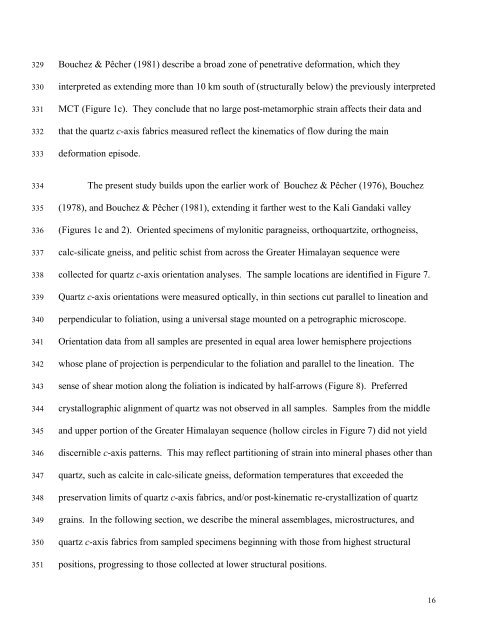Kinematics of the Greater Himalayan sequence, Dhaulagiri Himal ...
Kinematics of the Greater Himalayan sequence, Dhaulagiri Himal ...
Kinematics of the Greater Himalayan sequence, Dhaulagiri Himal ...
Create successful ePaper yourself
Turn your PDF publications into a flip-book with our unique Google optimized e-Paper software.
329<br />
330<br />
331<br />
332<br />
333<br />
Bouchez & Pêcher (1981) describe a broad zone <strong>of</strong> penetrative deformation, which <strong>the</strong>y<br />
interpreted as extending more than 10 km south <strong>of</strong> (structurally below) <strong>the</strong> previously interpreted<br />
MCT (Figure 1c). They conclude that no large post-metamorphic strain affects <strong>the</strong>ir data and<br />
that <strong>the</strong> quartz c-axis fabrics measured reflect <strong>the</strong> kinematics <strong>of</strong> flow during <strong>the</strong> main<br />
deformation episode.<br />
334<br />
335<br />
336<br />
337<br />
338<br />
339<br />
340<br />
341<br />
342<br />
343<br />
344<br />
345<br />
346<br />
347<br />
348<br />
349<br />
350<br />
351<br />
The present study builds upon <strong>the</strong> earlier work <strong>of</strong> Bouchez & Pêcher (1976), Bouchez<br />
(1978), and Bouchez & Pêcher (1981), extending it far<strong>the</strong>r west to <strong>the</strong> Kali Gandaki valley<br />
(Figures 1c and 2). Oriented specimens <strong>of</strong> mylonitic paragneiss, orthoquartzite, orthogneiss,<br />
calc-silicate gneiss, and pelitic schist from across <strong>the</strong> <strong>Greater</strong> <strong><strong>Himal</strong>ayan</strong> <strong>sequence</strong> were<br />
collected for quartz c-axis orientation analyses. The sample locations are identified in Figure 7.<br />
Quartz c-axis orientations were measured optically, in thin sections cut parallel to lineation and<br />
perpendicular to foliation, using a universal stage mounted on a petrographic microscope.<br />
Orientation data from all samples are presented in equal area lower hemisphere projections<br />
whose plane <strong>of</strong> projection is perpendicular to <strong>the</strong> foliation and parallel to <strong>the</strong> lineation. The<br />
sense <strong>of</strong> shear motion along <strong>the</strong> foliation is indicated by half-arrows (Figure 8). Preferred<br />
crystallographic alignment <strong>of</strong> quartz was not observed in all samples. Samples from <strong>the</strong> middle<br />
and upper portion <strong>of</strong> <strong>the</strong> <strong>Greater</strong> <strong><strong>Himal</strong>ayan</strong> <strong>sequence</strong> (hollow circles in Figure 7) did not yield<br />
discernible c-axis patterns. This may reflect partitioning <strong>of</strong> strain into mineral phases o<strong>the</strong>r than<br />
quartz, such as calcite in calc-silicate gneiss, deformation temperatures that exceeded <strong>the</strong><br />
preservation limits <strong>of</strong> quartz c-axis fabrics, and/or post-kinematic re-crystallization <strong>of</strong> quartz<br />
grains. In <strong>the</strong> following section, we describe <strong>the</strong> mineral assemblages, microstructures, and<br />
quartz c-axis fabrics from sampled specimens beginning with those from highest structural<br />
positions, progressing to those collected at lower structural positions.<br />
16

















